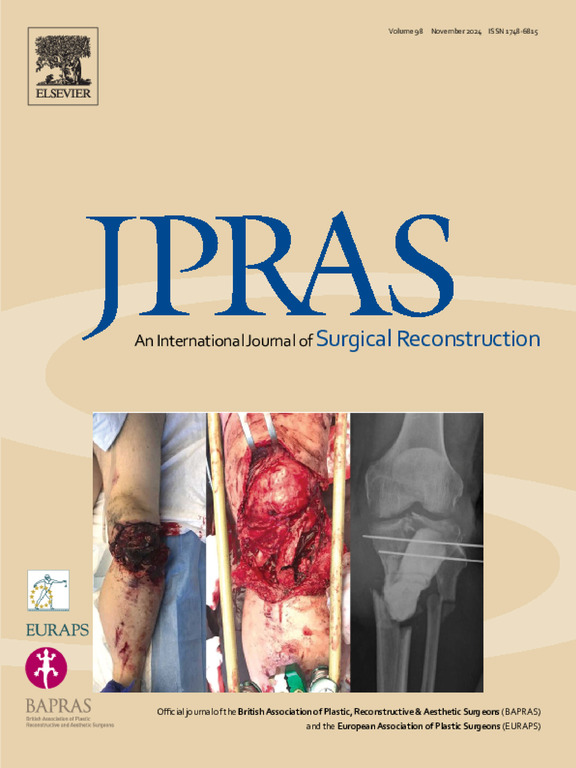手部和前臂部分伸肌腱撕裂伤的处理:英国一项全国性的实践调查。
IF 2
3区 医学
Q2 SURGERY
Journal of Plastic Reconstructive and Aesthetic Surgery
Pub Date : 2025-02-01
DOI:10.1016/j.bjps.2024.11.028
引用次数: 0
摘要
背景:手部和前臂的部分伸肌腱撕裂是常见的。缺乏指导其治疗的证据,也不清楚外科医生认为修复的阈值是多少。本研究旨在确定手和前臂(2-8区)部分伸肌腱撕裂伤的国家外科治疗方法,并评估外科医生在未来试验中随机化的意愿。方法:指导小组制定了一份包含34个项目的在线调查,并通过实习生主导的合作模式,向英国的整形和矫形外科医生传播。对每个调查项目进行汇总数据计算,并利用线性回归探讨不同地区和专业之间的差异。结果:完整应答142例,有效率71%。平均而言,受访者表示46%的肌腱分裂是他们在临床实践中不进行手术修复的最大值。在不同地区或外科专科之间,这一比例没有显著差异。重要的是,大多数(83%)的外科医生愿意在临床试验中随机分配患者进行修复或不修复,在29%-61%的肌腱分裂范围内,证明临床平衡。结论:对于手部和前臂部分伸肌腱撕裂伤的手术处理,英国的实践存在显著差异,在决定是否修复方面存在临床平衡。有必要进行一项明确的随机试验,以确定这种常见损伤的最佳治疗方法。本文章由计算机程序翻译,如有差异,请以英文原文为准。
Management of partial extensor tendon lacerations of the hand and forearm: A national survey of practice in the United Kingdom
Background
Partial extensor tendon lacerations of the hand and forearm are common. There is a lack of evidence to guide their management and it is also unclear at what threshold surgeons would consider repair necessary. This study aimed to identify national surgical management of partial extensor tendon lacerations of the hand and forearm (zones 2–8) and assess surgeons’ willingness to randomise in a future trial.
Methods
A 34-item online survey was developed by the steering group and, via a trainee-led collaborative model, was disseminated to plastic and orthopaedic surgeons in the UK. Summary data were calculated for each survey item, and the variations between zones and specialties were explored using linear regression.
Results
142 complete responses were recorded (response rate 71%). On average, respondents said that 46% tendon division was the maximum they would manage in clinical practice without surgical repair. There was no significant difference in this percentage between zones or surgical specialties. Importantly, the majority (83%) of surgeons would be willing to randomise patients in a clinical trial to repair versus no-repair, within 29%−61% tendon division, demonstrating clinical equipoise.
Conclusions
There is significant variation in UK practice regarding the surgical management of partial extensor tendon lacerations of the hand and forearm and clinical equipoise exists regarding the decision to repair or not. A definitive randomised trial is warranted to identify the optimum management of this common injury.
求助全文
通过发布文献求助,成功后即可免费获取论文全文。
去求助
来源期刊
CiteScore
3.10
自引率
11.10%
发文量
578
审稿时长
3.5 months
期刊介绍:
JPRAS An International Journal of Surgical Reconstruction is one of the world''s leading international journals, covering all the reconstructive and aesthetic aspects of plastic surgery.
The journal presents the latest surgical procedures with audit and outcome studies of new and established techniques in plastic surgery including: cleft lip and palate and other heads and neck surgery, hand surgery, lower limb trauma, burns, skin cancer, breast surgery and aesthetic surgery.

 求助内容:
求助内容: 应助结果提醒方式:
应助结果提醒方式:


